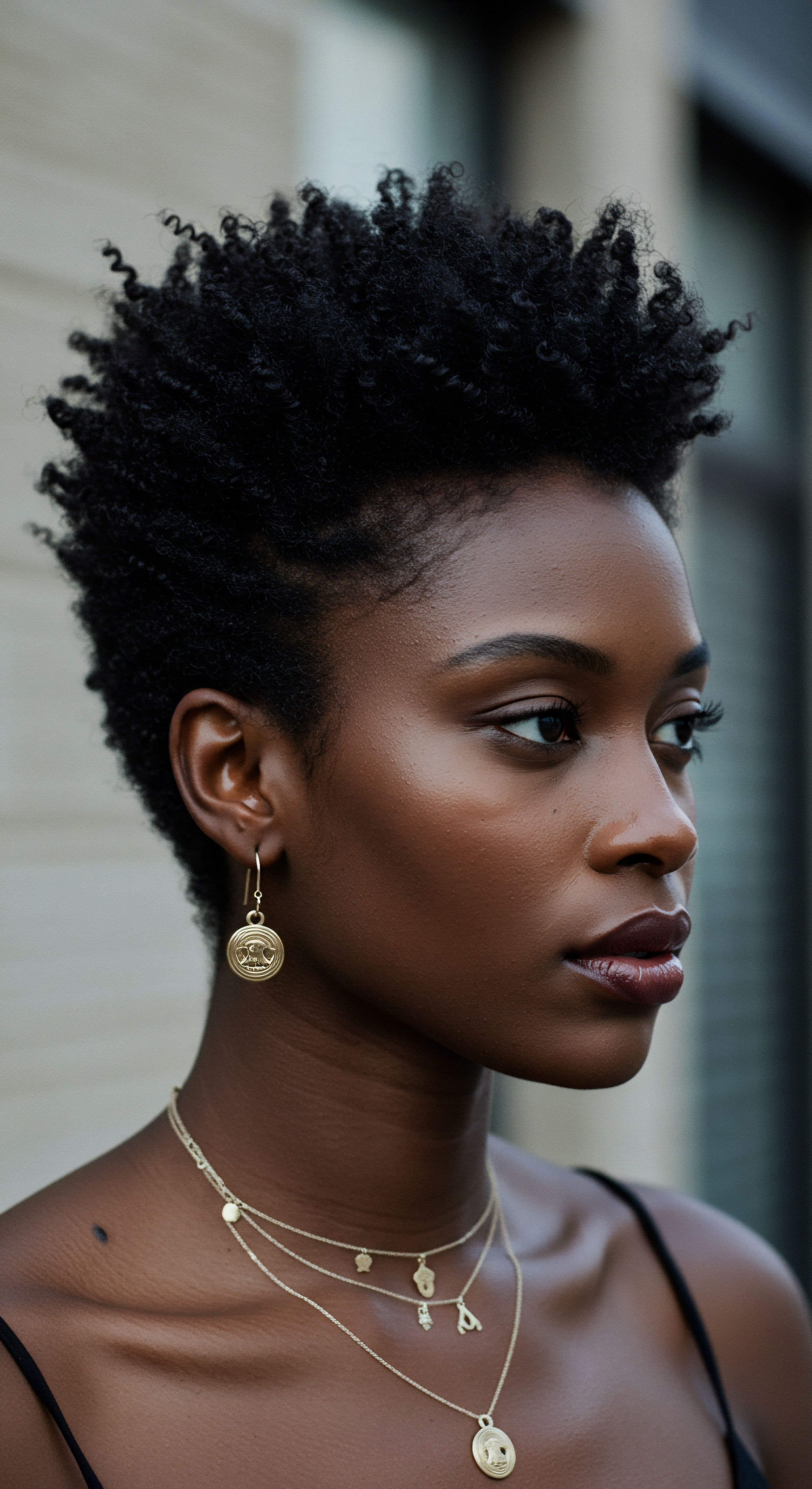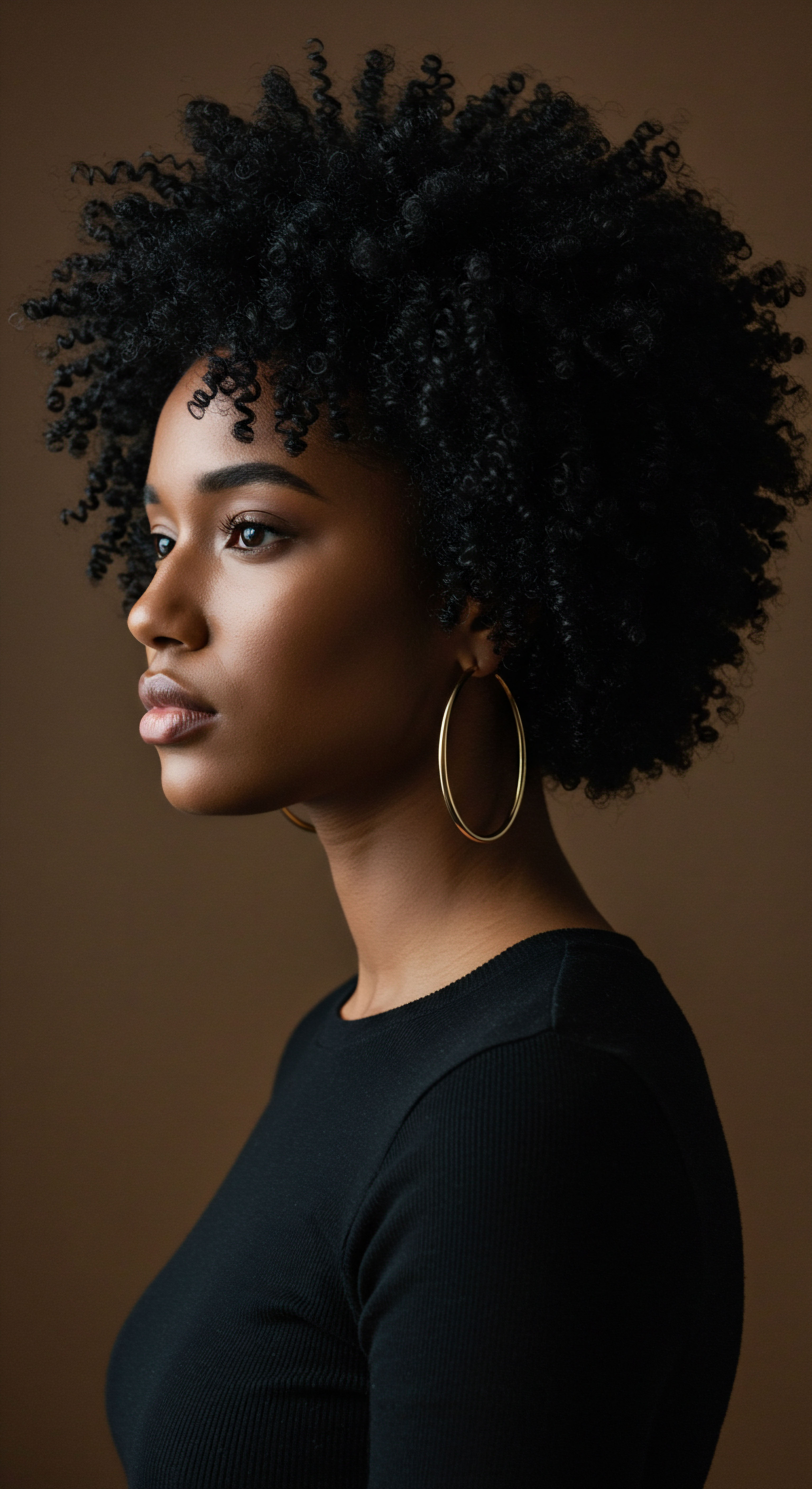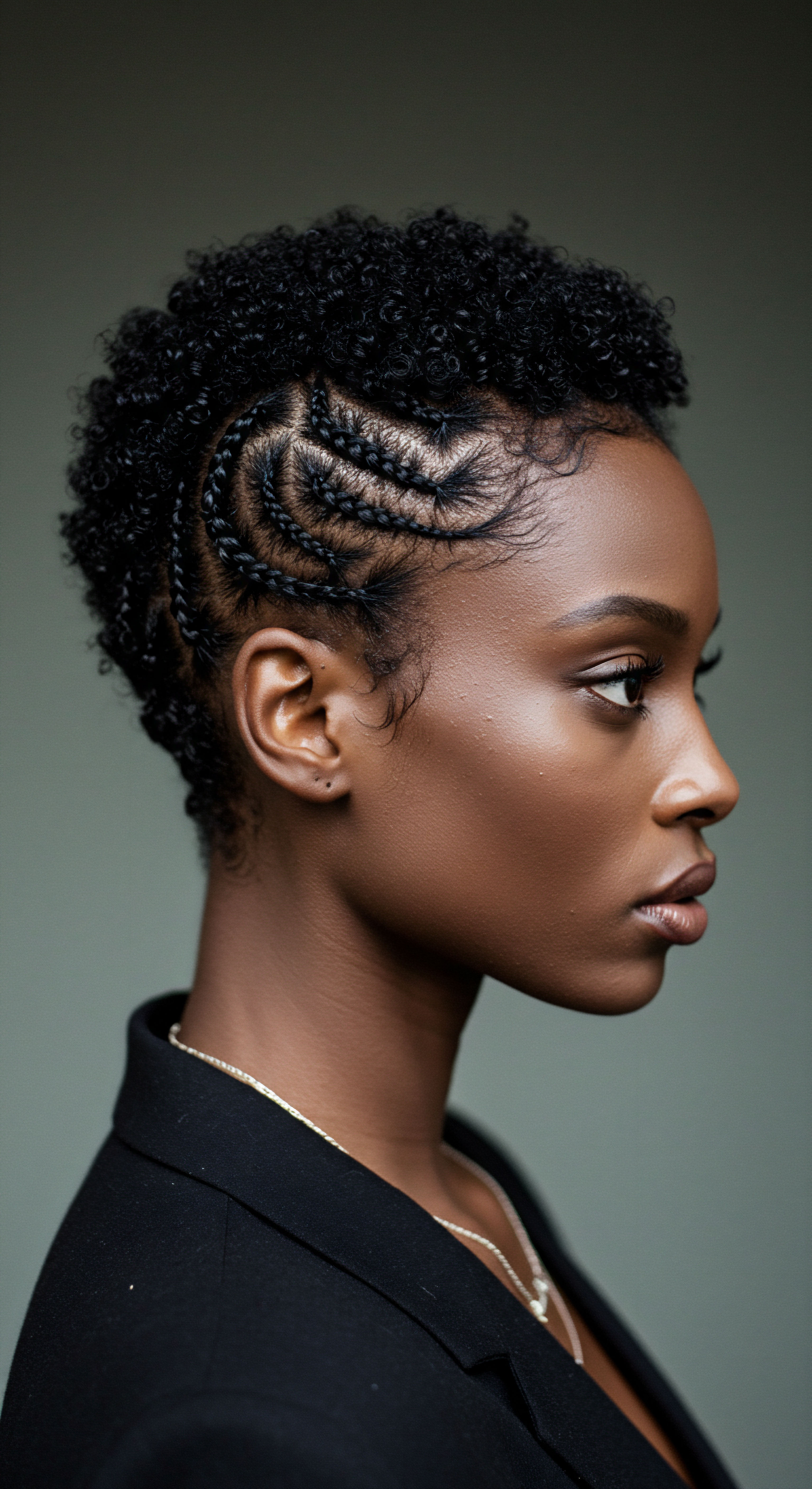
Roots
The quiet rhythm of life unfolds, and with it, the subtle workings of our being often remain unexamined, yet they hold keys to profound understanding. Consider the very crown of our existence, the scalp, a living landscape often veiled from direct sight, and its intricate relationship with the hair it nurtures. What happens beneath that covering, that protective layer we sometimes place upon it, whether for styling, warmth, or cultural expression?
How does this sustained covering, this scalp occlusion, truly speak to the hair follicles nestled within? This inquiry beckons us to look beyond the surface, to the foundational elements that orchestrate hair’s vitality.
At the core of hair health lies the follicle, a marvel of biological design. Each hair strand begins its journey deep within the dermis, originating from this tiny, dynamic organ. The follicle is more than just a tube; it is a complex mini-organ, complete with its own blood supply, nerve endings, and sebaceous glands. These glands produce sebum, a natural oil that coats the hair and scalp, providing a protective barrier and contributing to moisture balance.
The dermal papilla, a cluster of cells at the base of the follicle, receives nutrients from the bloodstream and plays a critical role in hair growth and regeneration. Understanding this delicate ecosystem is the first step in appreciating the profound implications of any external influence, such as sustained occlusion.
The scalp itself forms a unique microenvironment, a living skin layer with its own delicate balance. Its surface is home to a diverse community of microorganisms, a microbiome that includes bacteria, fungi, and mites. This microbial community, when in equilibrium, contributes to the scalp’s protective functions. Factors like pH, temperature, and humidity directly influence this balance.
A healthy scalp typically maintains a slightly acidic pH, which discourages the growth of harmful pathogens. The continuous shedding of skin cells, along with sebum production, forms a natural renewal process that keeps the environment optimal for follicle activity. When this environment is altered, even subtly, the effects can ripple down to the very root of hair health.
Hair growth proceeds in distinct phases, a cycle of renewal that governs the life of each strand. The Anagen Phase marks the active growth period, where hair cells divide rapidly, pushing the hair shaft outward. This can last for several years. Following this, the Catagen Phase, a brief transitional period, signals the end of active growth as the follicle shrinks.
Finally, the Telogen Phase is a resting period, during which the hair strand remains in the follicle before eventually shedding to make way for new growth. Disruptions to this cycle, often stemming from compromised follicle health, can manifest as thinning, breakage, or slowed growth. Sustained changes to the scalp environment, particularly those brought about by occlusion, can subtly interfere with these natural rhythms, challenging the follicle’s ability to perform its vital function.
The scalp’s intricate ecosystem and the hair follicle’s delicate growth cycle are foundational to understanding how sustained covering can alter hair health.
When we consider the interplay of these elements, the impact of sustained scalp occlusion begins to take shape. Occlusion, in essence, creates a sealed environment, trapping heat and moisture, and altering air circulation. This can significantly shift the scalp’s natural temperature and humidity levels, potentially disrupting the delicate balance of its microbiome and the normal function of sebaceous glands.
The follicle, relying on an optimal environment for its complex processes, becomes subject to these altered conditions. The initial thoughts on this connection suggest a potential for both benefit, in terms of moisture retention, and challenge, in terms of microbial shifts or impaired scalp respiration.

Ritual
Our daily practices, often imbued with personal significance and passed-down wisdom, quietly shape the story of our hair. From the intricate braiding patterns that honor heritage to the simple act of wrapping strands for sleep, these rituals form a significant part of our hair journey. Yet, within these cherished routines, the concept of sustained scalp occlusion takes on a practical dimension.
How do these common hair care practices, particularly those involving prolonged covering or sealing of the scalp, truly influence the well-being of our hair follicles? It is a question that invites us to examine the techniques and tools we employ, and the subtle, sometimes unforeseen, consequences that arise.
Many protective styles, designed to shield delicate strands from environmental stressors and manipulation, inherently involve a degree of scalp occlusion. Styles such as braids, twists, weaves, and even certain wig applications, can cover large portions of the scalp for extended periods. While these styles are invaluable for reducing breakage and promoting length retention, their occlusive nature can alter the microclimate directly surrounding the hair follicles.
The very act of sealing off the scalp, whether by the tightness of the style or the material of the extension, creates a warmer, more humid environment underneath. This shift, while often beneficial for moisture retention within the hair shaft, poses a distinct consideration for the scalp itself.
The products we choose to adorn our hair also contribute to the occlusive landscape. Heavy butters, thick oils, and certain gels, when applied directly to the scalp or near the roots, can create a physical barrier. While intended to moisturize or provide hold, these formulations can inadvertently contribute to a sealed environment, limiting the scalp’s natural respiration.
This becomes particularly relevant when such products are applied frequently and without thorough cleansing, allowing layers to accumulate. The synergy between protective styling and product application can amplify the occlusive effect, making it paramount to consider how these elements interact with the scalp’s delicate balance.

Does Prolonged Product Application Harm the Scalp?
Prolonged product application, especially of heavier, occlusive formulations, can indeed present challenges to scalp health. When products are not properly rinsed or cleansed, they can build up, creating a film that traps dead skin cells, sebum, and environmental debris. This accumulation can clog follicle openings, potentially leading to irritation or impeding the natural shedding process of the hair.
Moreover, a constantly moist and warm environment beneath layers of product can become a breeding ground for microorganisms, disrupting the scalp’s natural microbiome. It becomes a delicate balance between providing nourishment and allowing the scalp to breathe and cleanse itself effectively.
| Practice Braids (e.g. box braids, cornrows) |
| Description Hair sectioned and woven into tight patterns, often with extensions. |
| Scalp Occlusion Level Moderate to High |
| Primary Scalp Consideration Tension, limited air circulation, product build-up. |
| Practice Wigs/Weaves |
| Description Hair covered by a cap or foundation, with extensions sewn or glued on. |
| Scalp Occlusion Level High |
| Primary Scalp Consideration Heat and moisture retention, potential for trapped sweat/sebum. |
| Practice Bonnets/Wraps (for sleep) |
| Description Fabric covering used to protect hair overnight. |
| Scalp Occlusion Level Low to Moderate |
| Primary Scalp Consideration Moisture retention, potential for heat if material is non-breathable. |
| Practice Heavy Butters/Oils on Scalp |
| Description Application of dense products directly to the scalp. |
| Scalp Occlusion Level Moderate |
| Primary Scalp Consideration Clogged pores, microbial environment shifts. |
| Practice Careful consideration of product choice and cleansing frequency can mitigate risks associated with these practices. |
The immediate effects of scalp occlusion often manifest as increased moisture retention. For textured hair, which tends to be prone to dryness, this can be a welcome benefit, helping to keep strands supple and reduce brittleness. However, this moisture comes with an accompanying rise in scalp temperature, particularly when non-breathable materials are used or when styles are worn for extended periods.
This warm, humid environment, while aiding hair shaft hydration, can simultaneously create conditions less than ideal for the scalp’s microbial equilibrium. It is a nuanced reality, where a desired outcome for the hair fiber might inadvertently create a different challenge for the living skin beneath.
Hair care rituals, especially protective styles and product use, create a delicate balance of moisture retention for strands versus potential microenvironmental shifts on the scalp.
Many common concerns related to occlusive practices revolve around irritation and discomfort. An itchy scalp, redness, or even small bumps can signal that the scalp environment is out of balance. These symptoms often stem from a combination of factors ❉ insufficient cleansing allowing product and sweat to accumulate, increased microbial activity, or simply the physical tension of a tight style.
Addressing these concerns requires a mindful approach to scalp care, ensuring that while hair is protected, the scalp remains clean, breathable, and calm. The ritual of care extends beyond the hair itself, encompassing the vital foundation from which it grows.

Relay
To truly comprehend the layered conversation between sustained scalp occlusion and hair follicle health, we must move beyond the visible and the immediately felt, venturing into the intricate biological and even cultural dialogues that shape this experience. What hidden processes unfold when the scalp remains consistently covered, and how do these processes ultimately speak to the vitality of our hair? This segment seeks to connect the dots, drawing upon scientific understanding and the rich tapestry of human practices to offer a more profound understanding of this complex interplay.
The biological mechanisms at play beneath an occluded scalp are remarkably dynamic. When the scalp is consistently covered, a microclimate forms, characterized by elevated temperature and humidity. This altered environment can have several consequences. Firstly, it can influence the scalp’s natural pH, shifting it from its slightly acidic state.
A higher pH can compromise the skin’s barrier function, making it more susceptible to external irritants and microbial overgrowth. Secondly, the increased warmth and moisture create an ideal breeding ground for certain microorganisms. While the scalp microbiome is naturally diverse, an imbalance, or dysbiosis, can lead to the proliferation of specific species, such as lipophilic yeasts like Malassezia .

How does a Changed Scalp Microenvironment Affect Follicle Health?
A changed scalp microenvironment, particularly one characterized by increased warmth and humidity due to sustained occlusion, can significantly affect follicle health through several pathways. The proliferation of certain microorganisms, notably Malassezia species, can lead to inflammatory responses. Research has shown that an overgrowth of Malassezia is frequently associated with seborrheic dermatitis, a common inflammatory scalp condition marked by redness, flaking, and itching.
This inflammation, if chronic, can directly impact the hair follicle, potentially leading to follicular damage, miniaturization of hair strands, or even premature hair shedding. The follicle, under constant inflammatory stress, struggles to maintain its normal growth cycle and produce healthy, robust hair.
Consider a study published in the Journal of Clinical and Aesthetic Dermatology by G. S. Gupta and colleagues, which explored the prevalence of various scalp conditions. While not solely focused on occlusion, it underscores the susceptibility of the scalp to conditions like seborrheic dermatitis, which are often exacerbated by environmental factors such as humidity and warmth.
A key observation from dermatological literature, often discussed in relation to scalp conditions, is that prolonged conditions of increased moisture and reduced air circulation can indeed shift the microbial balance, favoring the growth of opportunistic pathogens or overgrowth of commensal organisms like Malassezia. For instance, in a review of environmental factors influencing scalp health, it is noted that environments with elevated humidity and temperature can create conditions conducive to Malassezia proliferation, which, while a normal inhabitant, can become problematic when its population increases significantly. This subtle shift, though often unseen, can lead to chronic low-grade inflammation around the follicle, impacting its long-term viability.
Sustained scalp occlusion can shift the scalp’s microclimate, potentially fostering microbial imbalances and inflammatory conditions that compromise hair follicle vitality.
Beyond microbial shifts, prolonged occlusion can also impact sebum regulation and sweat evaporation. The sebaceous glands, designed to lubricate the scalp and hair, may become overactive or their secretions may become trapped, leading to clogged pores. This can result in conditions like folliculitis, an inflammation of the hair follicles themselves, presenting as small, tender bumps.
The inability of sweat to evaporate naturally can also contribute to maceration of the scalp skin, weakening its barrier and making it more vulnerable to irritation and infection. The mechanical tension associated with some occlusive styles, like tight braids or weaves, adds another layer of stress, contributing to traction alopecia, a form of hair loss caused by repetitive pulling on the hair follicles.
The cultural context surrounding scalp covering and protective styling is deeply ingrained, particularly within textured hair communities. For generations, practices like wrapping hair in scarves, wearing wigs, or styling in intricate braids have served multiple purposes ❉ protecting hair from environmental damage, maintaining moisture, expressing identity, and adhering to cultural or religious customs. These practices are often born of necessity and wisdom, passed down through families.
The challenge lies in harmonizing these deeply valued traditions with a contemporary understanding of scalp biology. It is not about dismissing these practices, but rather about approaching them with informed mindfulness, recognizing the delicate balance between protecting the hair shaft and maintaining the scalp’s inherent health.
Understanding the long-term consequences of sustained occlusion requires a holistic perspective. Chronic inflammation, repeated episodes of folliculitis, or persistent microbial imbalances can, over time, lead to permanent damage to hair follicles. This damage can manifest as scarring alopecia, where the follicle is destroyed and replaced by scar tissue, rendering it incapable of producing hair. The interplay of genetic predispositions, individual sebum composition, external environmental factors, and the specific occlusive practices adopted all contribute to the overall outcome.
- Microbial Imbalance ❉ Prolonged warmth and humidity beneath an occlusive layer can encourage the overgrowth of certain yeasts and bacteria, disrupting the scalp’s natural microbiome.
- Follicular Inflammation ❉ The presence of irritating microorganisms or trapped sebum can lead to inflammation around the hair follicle, potentially causing discomfort and impairing hair growth.
- Sebum Regulation ❉ Occlusion can alter the natural flow and distribution of sebum, sometimes leading to accumulation and clogged pores, which can contribute to various scalp conditions.
Preventative measures become paramount in this nuanced understanding. These include regular, gentle cleansing of the scalp, even when hair is in protective styles, using breathable materials for wraps and bonnets, and ensuring that protective styles are not excessively tight. The frequency of style changes also plays a role, allowing the scalp periodic exposure to air and light. This mindful approach allows individuals to continue cherishing their cultural practices and protective styling benefits while safeguarding the foundational health of their hair follicles.

Reflection
As we peel back the layers of understanding surrounding scalp occlusion and its quiet conversation with hair follicle health, a clearer picture emerges. It is a testament to the intricate design of our bodies and the profound ways our practices, however seemingly simple, can influence deeply rooted biological processes. The journey into this topic reminds us that true hair vitality extends beyond the visible strand, reaching into the very soil from which it grows. It is a continuous invitation to listen to our bodies, to observe the subtle shifts, and to adapt our care with informed tenderness, honoring both tradition and scientific insight.

References
- Gupta, G. S. et al. (2014). “Prevalence of Scalp Conditions and Their Association with Hair Care Practices Among African American Women.” Journal of Clinical and Aesthetic Dermatology, 7(11), 36-42.
- Clavaud, C. et al. (2013). “Scalp microbiota in healthy and diseased conditions.” Frontiers in Cellular and Infection Microbiology, 3, 70.
- Akagi, T. et al. (2017). “Effects of long-term skin occlusion on stratum corneum hydration and barrier function.” Journal of Dermatological Science, 87(2), 173-179.
- Rele, A. S. & Mohile, R. B. (2014). “Skin pH and its implications in hair and scalp health.” International Journal of Trichology, 6(2), 65-68.
- Oh, J. et al. (2016). “The skin microbiome and its relation to health and disease.” Microbiology Spectrum, 4(5), 4.5.15.
- Giacomoni, P. U. & Maibach, H. I. (Eds.). (2018). Textbook of Cosmetic Dermatology. CRC Press.
- Dawber, R. P. R. & Van Neste, D. (1995). Hair and Scalp Disorders ❉ Common Problems and Their Management. Blackwell Science.